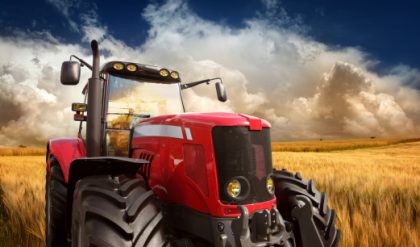As discussed in the previous lesson, weighing method can be applied for determining the location of the centre of gravity in laboratory conditions. From the Fig.s 2.1 and 2.2, the various parameters can be determined.

Following parameters are measured before taking the tractor to a weighing balance:
· Wheelbase of the tractor
· Radius of front and rear wheels
· Height of the centres of front and rear wheels from the ground
When on the weighing balance, the parameters noted are:
· Total weight of the tractor
· Weight coming on the front and rear tyres.
These parameters are also measured when the front wheels are lifted by a height ‘h’.
From Fig. 2.1
Wx2-Rf X1=0
or  ………..(1)
………..(1)
so, a vertical transverse plane containing C.G. can be determine by the equation (1)
the front wheel of the tractor are raised distance Y2 and R’f is determined by weighing.
From Fig.1.2
Wx’2-R´f X´1 = 0

From fig. 1.2
tan β1 = x4 / y3 (2)
and tan β1 = (x2 – x3) / y3 (3)
or y3 = (x2 – x3) / tan β1
and cos β1 = x2´/ x3 (4)
or x3 = x2´/ cos β1
 (5)
(5)
Hence the height of CG from the ground is given by

where is the diameter of the rear wheel.
Some assumptions while doing this analysis were:
1. The displacement of the point of contact of rear wheel on the ground as the front wheels are lifted is negligible.
2. There is no deformation of the pneumatic tyre at the point of contact i.e. height of centre of rear wheel is same as the radius of the rear wheel.

